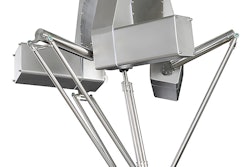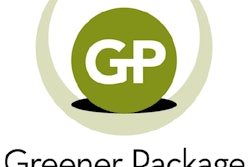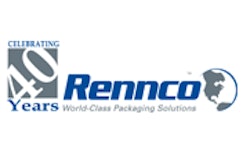
Included among the sustainable achievements announced during a Web event on May 28 in the 21st DuPont Awards for Packaging Innovation were innovations in the use of renewable materials, effective recovery, energy efficiency and community benefit. A panel of independent jurors—facilitated by Anne Johnson, director of the Sustainable Packaging Coalition— selected this year's winners from more than 120 entries received from around the world.
“Sustainable packaging is a growing and important focus area for DuPont and demand continues to grow across multiple sectors despite the economy,” said William F. Weber, vice president and general manager -- DuPont Packaging & Industrial Polymers. “At DuPont, we work with consumer goods companies to minimize packaging content and improve environmental performance, as well as to be more cost-effective. This year’s award submissions also demonstrated a focus on source reduction, which provides the double benefit of an improved product environmental profile and cost reduction.”
During the event, members of the program’s independent jury panel provided their perspectives on the achievements of 10 winners from a diverse cross-section of food, pharmaceutical, cosmetics, and other packaging segments.
Julian Carroll, managing director of the European Organization for Packaging and the Environment (EUROPEN), led an interactive session on issues arising from lack of consensus on standards for reporting on the sustainability of packaging.
Ronald Cotterman, executive director of sustainability for Sealed Air Corp., led a session on future post-use solutions for packaging after it has fulfilled its primary purpose of protecting food and other products. The event has been archived and is available by registering using this link.
Ten winners (below) and eight notable achievements (see link at bottom) were honored for innovative products and processes that demonstrated breakthroughs in sustainable packaging.
Aveda ™ Vintage Clove Shampoo from The Esteé Lauder Companies - U.S.
Outstanding producer involvement and commitment to a take-back program and innovation in the use of post-consumer recycled material.
A proactive, company-funded collection program and outreach in retail stores and schools internationally is at the heart of this achievement, complementing the conversion to bottles with 96% recycled bottle content and caps with 100% post-consumer recycle polypropylene. Statements on the bottle promote recycling. The bottles are made at a plant that uses 100% renewable wind energy. Recognized for achievement in community education and responsible sourcing.
Whole Foods Baked Goods in Sealed Air's Renew-A-Pak™ compostable bakeware with technology from Biosphere Industries
Renewable, compostable tray makes possible the reinvention of retail baking practices and the simplification of the supply chain with considerable waste reduction.
This new, 100% renewable-content baking tray and total system thinking help change bakery processes for a more sustainable result. Previous bakery practice was to bake goods in disposable metal trays and transfer the goods to a second package for in-store sales. Ultimately that package would be disposed of by consumers as waste. Product now stays in the new dual-ovenable, microwavable trays all the way through to the consumer. The trays are compostable at end of life, eliminating aluminum tray disposal, the need for a second package, or the disposal of the tray as waste at end of life. Recognized for enhanced performance, resource and energy optimization, and effective recovery.
Ecolean Group's lightweight packaging
Revolutionary new approach to aseptic packaging cuts package weight by 50% and uses natural material to significantly reduce raw materials in the construction.
Innovative design and use of materials enables tremendous resource reduction and energy savings. The handle design eliminates the need for a separate rigid pouring holder. Empty packages weigh just 14 grams, a nearly 50% weight reduction compared to cartons, which are the current standard for aseptic packaging. Use of calcium carbonate (chalk) reduces the amount of polymer needed in the structure. The low weight and volume enable substantially higher quantities of the product to be shipped per truck. Recognized for enhanced performance and clean production.
Healthy Choice Trays from ConAgra, developed and produced by Associated Packaging Technologies - U.S.
In an outstanding use of recycled content, 40% post-consumer recycled material and offsets need for virgin PET and supports the market for PCR material in these new frozen food trays.
A significant achievement is the high recycled content, a first in dual-ovenable food packaging. In 2008, 8 million pounds of PET were saved from the landfill and 236 million less BTUs of energy were used in the making of these trays due to the use of recycled content. Typically, virgin CPET is used for this type application due to cleanliness requirements. The company met FDA requirements for the use of recycled content in this application. Recognized for resource and energy optimization, clean production, and responsible sourcing..
Invisible Case Polyouters
Procter & Gamble - Belgium and Turkey
Innovative clear polybag replaces corrugated for an 80% weight reduction and 20% volume compression, enabling more efficient transport and improved stock handling.
In a significant reduction of packaging material, P&G achieved compelling efficiencies, including more energy-efficient transport, by replacing corrugated with this polybag for multipacked detergent pouches. For the trade, the benefits include improved stock management and handling. Recognized for resource and energy optimization, cost effective economics, and enhanced performance.
All Days Pads in tray and hood carton
Procter & Gamble - Germany and U.S.
Retailers want to reduce the amount of packaging in their stores. Through total systems thinking, this product was redesigned for smaller packs, the tray tray-and and-hood carton design reduces material, and store labor and consumer appeal is improved on retail shelves. Less ink is used for an 80% printing savings. Performance is in the store is significantly improved. Recognized for enhanced performance, cost-effective economics, and resource and energy optimization.
Bertolli® pasta sauce pouches
Unilever and Amcor Flexibles - U.S.
Replacing glass jars with stand-up pouches uses 70% less material. This development overcame significant technical hurdles in shelf-stable packaging for this oxygen-sensitive product.
Now microwavable right in the pouch, this new packaging offers significant consumer benefit and ease of use versus jars and offers retail benefits through easier handling and equivalent shelf life. The benefits of transport efficiency are substantial. One truckload of unfilled pouches equals 25 truckloads of unfilled glass jars. Recognized for enhanced performance and resource and energy optimization.
Prilosec OTC Pack
Procter & Gamble and Alcan Packaging - U.S.
Redesign of pill pack reduces waste and enables entire course of treatment on a single blister card.
Good systems thinking enabled this major redesign of an industry-standard approach. This achievement doubled the number of pills on a blister card so that the consumer can have an entire course of treatment on a single card. This significantly cut waste in the packaging. Recognized for cost effective economics and enhanced performance.
Pangea Organics holiday gift boxes
Pangea Organics - U.S.
Changing to an all-renewable/recycled/biodegradable carton and label supports this product's organic branding while retaining shelf appeal.
Among the first significant sustainability achievements in the gift box category, this redesign fits with the brand's organic positioning and retained attractiveness while substantially reducing the amount of packaging. The carton is now entirely made of renewable, recyclable or biodegradable material and uses vegetable-based inks. Seeds are embedded in the carton which can be planted following use. Recognized for resource & energy optimization, effective recovery and community benefit.
Easy Pour Barrier Containers
A & C Packers – Australia
Redesigned 20-L drums are 30% more efficient for transport and storage, reusable, and recycled at end of life.
This new barrier structure replaces steel drums in most common solvent applications and is reusable with a five-year life compared to previous one-time use. The innovative design enables better stacking and cube efficiency – up to a 30% improvement. The new Easy Pour neck design also helps avoid spills or splashing when pouring. At end of life, the containers are recycled for items such as drain pipes. Recognized for effective recovery and enhanced performance.
For further information including the eight notables winners and individual photos of all the developments that were honored, see www.dupontevents.com/custom/awards_2009/award.aspx
Also look for the full coverage based on interviews and more details from the winners in the July issue of Packaging World and here at Packworld.com.
“Sustainable packaging is a growing and important focus area for DuPont and demand continues to grow across multiple sectors despite the economy,” said William F. Weber, vice president and general manager -- DuPont Packaging & Industrial Polymers. “At DuPont, we work with consumer goods companies to minimize packaging content and improve environmental performance, as well as to be more cost-effective. This year’s award submissions also demonstrated a focus on source reduction, which provides the double benefit of an improved product environmental profile and cost reduction.”
During the event, members of the program’s independent jury panel provided their perspectives on the achievements of 10 winners from a diverse cross-section of food, pharmaceutical, cosmetics, and other packaging segments.
Julian Carroll, managing director of the European Organization for Packaging and the Environment (EUROPEN), led an interactive session on issues arising from lack of consensus on standards for reporting on the sustainability of packaging.
Ronald Cotterman, executive director of sustainability for Sealed Air Corp., led a session on future post-use solutions for packaging after it has fulfilled its primary purpose of protecting food and other products. The event has been archived and is available by registering using this link.
Ten winners (below) and eight notable achievements (see link at bottom) were honored for innovative products and processes that demonstrated breakthroughs in sustainable packaging.
Aveda ™ Vintage Clove Shampoo from The Esteé Lauder Companies - U.S.
Outstanding producer involvement and commitment to a take-back program and innovation in the use of post-consumer recycled material.
A proactive, company-funded collection program and outreach in retail stores and schools internationally is at the heart of this achievement, complementing the conversion to bottles with 96% recycled bottle content and caps with 100% post-consumer recycle polypropylene. Statements on the bottle promote recycling. The bottles are made at a plant that uses 100% renewable wind energy. Recognized for achievement in community education and responsible sourcing.
Whole Foods Baked Goods in Sealed Air's Renew-A-Pak™ compostable bakeware with technology from Biosphere Industries
Renewable, compostable tray makes possible the reinvention of retail baking practices and the simplification of the supply chain with considerable waste reduction.
This new, 100% renewable-content baking tray and total system thinking help change bakery processes for a more sustainable result. Previous bakery practice was to bake goods in disposable metal trays and transfer the goods to a second package for in-store sales. Ultimately that package would be disposed of by consumers as waste. Product now stays in the new dual-ovenable, microwavable trays all the way through to the consumer. The trays are compostable at end of life, eliminating aluminum tray disposal, the need for a second package, or the disposal of the tray as waste at end of life. Recognized for enhanced performance, resource and energy optimization, and effective recovery.
Ecolean Group's lightweight packaging
Revolutionary new approach to aseptic packaging cuts package weight by 50% and uses natural material to significantly reduce raw materials in the construction.
Innovative design and use of materials enables tremendous resource reduction and energy savings. The handle design eliminates the need for a separate rigid pouring holder. Empty packages weigh just 14 grams, a nearly 50% weight reduction compared to cartons, which are the current standard for aseptic packaging. Use of calcium carbonate (chalk) reduces the amount of polymer needed in the structure. The low weight and volume enable substantially higher quantities of the product to be shipped per truck. Recognized for enhanced performance and clean production.
Healthy Choice Trays from ConAgra, developed and produced by Associated Packaging Technologies - U.S.
In an outstanding use of recycled content, 40% post-consumer recycled material and offsets need for virgin PET and supports the market for PCR material in these new frozen food trays.
A significant achievement is the high recycled content, a first in dual-ovenable food packaging. In 2008, 8 million pounds of PET were saved from the landfill and 236 million less BTUs of energy were used in the making of these trays due to the use of recycled content. Typically, virgin CPET is used for this type application due to cleanliness requirements. The company met FDA requirements for the use of recycled content in this application. Recognized for resource and energy optimization, clean production, and responsible sourcing..
Invisible Case Polyouters
Procter & Gamble - Belgium and Turkey
Innovative clear polybag replaces corrugated for an 80% weight reduction and 20% volume compression, enabling more efficient transport and improved stock handling.
In a significant reduction of packaging material, P&G achieved compelling efficiencies, including more energy-efficient transport, by replacing corrugated with this polybag for multipacked detergent pouches. For the trade, the benefits include improved stock management and handling. Recognized for resource and energy optimization, cost effective economics, and enhanced performance.
All Days Pads in tray and hood carton
Procter & Gamble - Germany and U.S.
Retailers want to reduce the amount of packaging in their stores. Through total systems thinking, this product was redesigned for smaller packs, the tray tray-and and-hood carton design reduces material, and store labor and consumer appeal is improved on retail shelves. Less ink is used for an 80% printing savings. Performance is in the store is significantly improved. Recognized for enhanced performance, cost-effective economics, and resource and energy optimization.
Bertolli® pasta sauce pouches
Unilever and Amcor Flexibles - U.S.
Replacing glass jars with stand-up pouches uses 70% less material. This development overcame significant technical hurdles in shelf-stable packaging for this oxygen-sensitive product.
Now microwavable right in the pouch, this new packaging offers significant consumer benefit and ease of use versus jars and offers retail benefits through easier handling and equivalent shelf life. The benefits of transport efficiency are substantial. One truckload of unfilled pouches equals 25 truckloads of unfilled glass jars. Recognized for enhanced performance and resource and energy optimization.
Prilosec OTC Pack
Procter & Gamble and Alcan Packaging - U.S.
Redesign of pill pack reduces waste and enables entire course of treatment on a single blister card.
Good systems thinking enabled this major redesign of an industry-standard approach. This achievement doubled the number of pills on a blister card so that the consumer can have an entire course of treatment on a single card. This significantly cut waste in the packaging. Recognized for cost effective economics and enhanced performance.
Pangea Organics holiday gift boxes
Pangea Organics - U.S.
Changing to an all-renewable/recycled/biodegradable carton and label supports this product's organic branding while retaining shelf appeal.
Among the first significant sustainability achievements in the gift box category, this redesign fits with the brand's organic positioning and retained attractiveness while substantially reducing the amount of packaging. The carton is now entirely made of renewable, recyclable or biodegradable material and uses vegetable-based inks. Seeds are embedded in the carton which can be planted following use. Recognized for resource & energy optimization, effective recovery and community benefit.
Easy Pour Barrier Containers
A & C Packers – Australia
Redesigned 20-L drums are 30% more efficient for transport and storage, reusable, and recycled at end of life.
This new barrier structure replaces steel drums in most common solvent applications and is reusable with a five-year life compared to previous one-time use. The innovative design enables better stacking and cube efficiency – up to a 30% improvement. The new Easy Pour neck design also helps avoid spills or splashing when pouring. At end of life, the containers are recycled for items such as drain pipes. Recognized for effective recovery and enhanced performance.
For further information including the eight notables winners and individual photos of all the developments that were honored, see www.dupontevents.com/custom/awards_2009/award.aspx
Also look for the full coverage based on interviews and more details from the winners in the July issue of Packaging World and here at Packworld.com.
Companies in this article

























